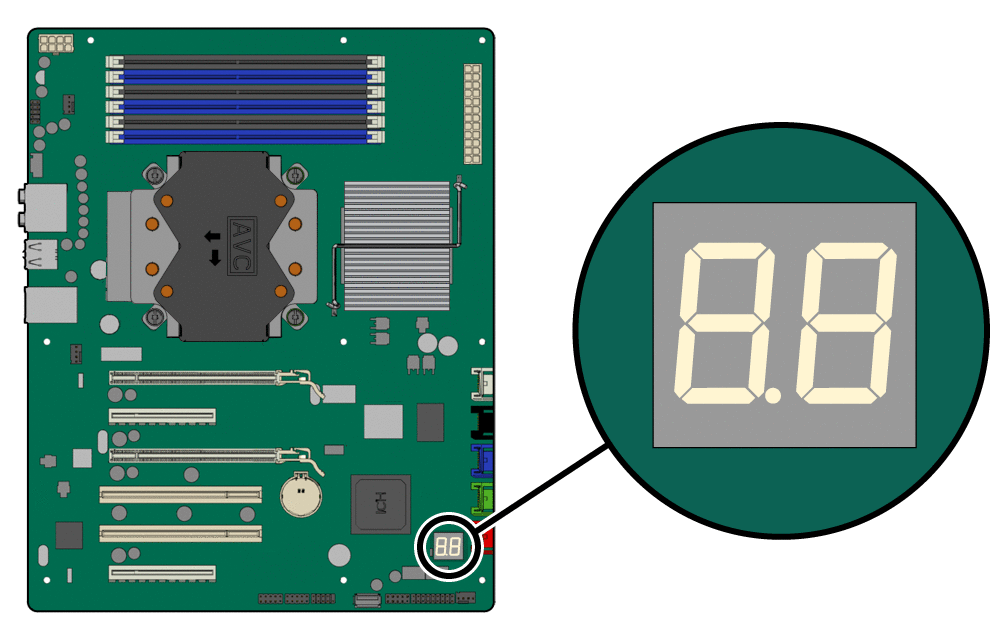|
03
|
Test CMOS R/W functionality.
|
|
04
|
Early chipset initialization:
|
|
05
|
Detect memory:
-
Auto detection of DRAM size, type, and ECC.
-
Auto detection of L2 cache (socket 7 or below).
|
|
06
|
Expand compressed BIOS code to DRAM.
|
|
07
|
Call chipset hook to copy BIOS back to E000 & F000 shadow RAM.
|
|
08
|
Expand the Xgroup codes located in physical address 1000:0.
|
|
C0
|
Reserved.
|
|
C1
|
Initial Superio_Early_Init switch.
|
|
C2
|
Reserved.
|
|
C5
|
1. Blank out screen.
2. Clear CMOS error flag.
|
|
C6
|
Reserved.
|
|
C7
|
1. Clear 8042 interface.
2. Initialize 8042 self-test.
|
|
0A
|
1. Test special keyboard controller for Winbond 977 series Super I/O
chips.
2. Enable keyboard interface.
|
|
0B
|
Reserved.
|
|
0C
|
1. Disable PS/2 mouse interface (optional).
2. Autodetect ports for keyboard and mouse followed by a port and interface
swap (optional).
3. Reset keyboard for Winbond 977 series Super I/O chips.
|
|
0E
|
Reserved.
|
|
13
|
Reserved.
|
|
20
|
Reserved.
|
|
24
|
Test F000h segment shadow to see whether it is read/writable or not.
If test fails, keep beeping the speaker.
|
|
2A
|
Reserved.
|
|
2C
|
Autodetect flash type to load appropriate flash R/W codes into the runtime
area in F000 for ESCD & DMI support.
|
|
2E
|
Reserved.
|
|
31
|
Use walking 1as algorithm to check out interface in CMOS circuitry.
Also, set real-time clock power status, and then check for override.
|
|
33
|
Reserved.
|
|
37
|
Program chipset default values into chipset. Chipset default values
are MODBINable by OEM customers.
|
|
38
|
Reserved.
|
|
39
|
Initial onboard clock generator if Early_Init_Onboard_Generator is defined.
See also POST 26h.
|
|
3A
|
Reserved.
|
|
3B
|
Detect CPU information including brand, SMI type (Cyrix or Intel), and
CPU level (586 or 686).
|
|
3C
|
Reserved.
|
|
40
|
Reserved.
|
|
52
|
Initial interrupts vector table. All hardware interrupts are directed
to SPURIOUS_INT_HDLR and software interrupts to SPURIOUS_soft_HDLR.
|
|
60
|
Reserved.
|
|
75
|
Initial EARLY_PM_INIT switch.
|
|
78
|
Reserved.
|
|
7C
|
Load keyboard matrix (notebook platform).
|
|
84
|
Reserved.
|
|
85
|
HPM initialization (notebook platform).
|
|
87
|
Reserved.
|
|
8C
|
1. Check validity of RTC value. For example, a value of 5Ah is an invalid
value for RTC minute.
2. Load CMOS settings into BIOS stack. If CMOS checksum fails, use default
value instead.
|
|
8D
|
Prepare BIOS resource map for PCI and PnP use. If ESCD is valid,
consider the ESCD as legacy information.
|
|
8E
|
Early PCI initialization:
-
Enumerate PCI bus number.
-
Assign memory and I/O resource.
-
Search for a valid VGA device and VGA BIOS, and put it into
C000:0.
|
|
90
|
1. If Early_Init_Onboard_Generator is not defined, Onboard clock generator
initialization. Disable respective clock resource to empty âPCI and
DIMM slots.
2. Initialize onboard PWM.
3. Initialize onboard H/W monitor devices.
|
|
A1
|
Initialize INT 09 buffer.
|
|
A2
|
Reserved.
|
|
A4
|
1. Program CPU internal MTRR (P6 and PII) for 0–640K memory address.
2. Initialize the APIC for Pentium class CPU.
3. Program early chipset according to CMOS setup. Example: âonboard
IDE controller.
4. Measure CPU speed.
|
|
A7
|
Reserved.
|
|
A9
|
Invoke video BIOS.
|
|
AA
|
Reserved.
|
|
AB
|
1. Initialize double-byte language font (optional).
2. Display information on screen, including award title, CPU type, CPU
speed, and full-screen logo.
|
|
AC
|
Reserved.
|
|
B1
|
Reserved.
|
|
00
|
Reserved.
|
 Table B–1 BIOS Port 80 POST Code Checkpoints
Table B–1 BIOS Port 80 POST Code Checkpoints 